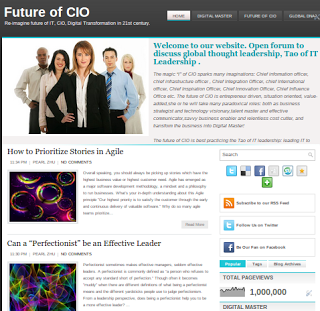Pearl Zhu's Blog, page 1418
July 30, 2015
Data Scientist vs. Data Algorithm
 An algorithm is a procedure or formula for solving a problem. An algorithm is a model of the real world. A data scientist is a job title for an employee or business intelligence (BI) consultant who excels at analyzing data, particularly large amounts of data, to help a business gain a competitive edge. (whatis.com). Do data scientists see themselves as an expert of all? A subject matter scientist is best equipped to author the algorithm. Is a data scientist an expert in behavior, physics, chemistry, biology, etc.?
An algorithm is a procedure or formula for solving a problem. An algorithm is a model of the real world. A data scientist is a job title for an employee or business intelligence (BI) consultant who excels at analyzing data, particularly large amounts of data, to help a business gain a competitive edge. (whatis.com). Do data scientists see themselves as an expert of all? A subject matter scientist is best equipped to author the algorithm. Is a data scientist an expert in behavior, physics, chemistry, biology, etc.?
Who is a good data scientist? Any good data scientist must be able to perform problem systems definition, data collection systems analysis integrating into strategic analytics modeling problem-solving operations simulation analysis algorithm and implementation to creating values. Very few people would think using / purchasing top of the line power tools would turn him or her into a master carpenter. So why anyone would believe that applying algorithms or software alone could turn him or her into a data scientist. The "scientist" concept in the open marketplace deal with universal issues, such as gravity or light that affect all humans - the data scientists deal with subject areas that affect a limited number of humans, but the protocols, procedures and everything else are practically the same. In a data science scenario, the data scientist should also be subject to peer review if the consumers expect their results to deal with high-risk scenarios. But to avoid bias and lack of blinding, the subject matter expert should not be the person building the model. And they should get more than one subject matter's opinion (as many as possible) about what candidate variables to consider, for example and other expert inputs and more than one modeler (if they use algorithms that require subjective and potentially biased human choices).
How to define a good algorithm? A good algorithm needs to be developed through integrating knowledge-based data into analytic models simulation testing, implemented for problem-solving. Some business modeling isn't validated, for good reason, because it is sufficiently proven by a performance that independent validation is not economically justified or that it is seen as the secret sauce. Algorithms are indeed nice tools for a data scientist. However, you need to keep in mind that underlying these algorithms are models, models with their own assumptions, strengths, and weaknesses. In addition, these algorithms require data and understanding the idiosyncrasies of these data are critical to model performance. And understanding how to synthesize new predictors in a way which increase the predictive power of these data are critical to increasing model performance. This is where the Data Scientist shows the true value, and where algorithms fall flat on their faces.-These models may predict the direction of an economy (usually large systems of simultaneous econometric equations) validated, independently reproduced, etc.- These models may describe and predict the outcomes of interactions between compounds and biological systems. These models often need to consider molecular structures as well as biological processes.- These models can predict and simulate human behavior through a sequence of events-They may be physical models that are estimating flow through a very dynamic situation using only differential frequency.
 Analytical algorithms and data scientist are not mutually exclusive, but they are absolutely complementary. The challenge is finding the right expertise. People with both great mathematical knowledge and great subject knowledge are the most valuable experts. The perfect machine operator who understands little about the business is not likely to share all the meta-data and peripheral insights that the model statistics expose. At least half the value of a good modeler comes from the insights gained and shared from the stuff that never made it into the final model. You need to understand the subject and purpose (how is value created) to do that well. When insights are gotten, you have to be careful that they are not an artifact of results confounded by human biases and sampling/data error. The entire reason for such rigorous blinded controlled replication validation in science is to rule out these confounding effects. Once you are fairly certain that predictions are not resulting from obvious confounds like human biases and data error, it is important to have very creative scientists and subject matter experts to interpret these results. It is often the case that the interpretation is not obvious, so there is often disagreement at this stage. If there is disagreement, new well controlled experiments need to be designed by your scientists to resolve those disagreements. Before you move to this second stage, it is important that you went through the first stage and verified that the original predictions were valid and could be trusted within a tight confidence interval. If you did not go through the first validation by replication stage, you are probably wasting your time when you try to gain any insights from predictions that cannot be trusted. A big component of predictions in science is that some objective attempt is made to estimate the confidence that one has in the predictions - whether formally with a confidence interval or with blinded controlled tests. Unless you are generating a reasonable estimate of the confidence that one has in your predictions and it is fairly tight, you are probably gambling with today's machine learning/predictive modeling. This is not science.
Analytical algorithms and data scientist are not mutually exclusive, but they are absolutely complementary. The challenge is finding the right expertise. People with both great mathematical knowledge and great subject knowledge are the most valuable experts. The perfect machine operator who understands little about the business is not likely to share all the meta-data and peripheral insights that the model statistics expose. At least half the value of a good modeler comes from the insights gained and shared from the stuff that never made it into the final model. You need to understand the subject and purpose (how is value created) to do that well. When insights are gotten, you have to be careful that they are not an artifact of results confounded by human biases and sampling/data error. The entire reason for such rigorous blinded controlled replication validation in science is to rule out these confounding effects. Once you are fairly certain that predictions are not resulting from obvious confounds like human biases and data error, it is important to have very creative scientists and subject matter experts to interpret these results. It is often the case that the interpretation is not obvious, so there is often disagreement at this stage. If there is disagreement, new well controlled experiments need to be designed by your scientists to resolve those disagreements. Before you move to this second stage, it is important that you went through the first stage and verified that the original predictions were valid and could be trusted within a tight confidence interval. If you did not go through the first validation by replication stage, you are probably wasting your time when you try to gain any insights from predictions that cannot be trusted. A big component of predictions in science is that some objective attempt is made to estimate the confidence that one has in the predictions - whether formally with a confidence interval or with blinded controlled tests. Unless you are generating a reasonable estimate of the confidence that one has in your predictions and it is fairly tight, you are probably gambling with today's machine learning/predictive modeling. This is not science.The point is that humans should all have some humility and recognize the limitations of their expertise and partner them with the other experts to apply the analytical algorithms for problem-solving. Then there is the opportunity to make something great. Sometimes, you will be unqualified, but still the most qualified resource available, but in other situation, strap on a set of ear and a little humility and help empower the other expert to get the job done.And if a data scientist wants to be called a "scientist" - words mean things - and the word "scientist" is invariably associated with the rigor of a quality outcome.Follow us at: @Pearl_Zhu
Published on July 30, 2015 00:00
July 29, 2015
What’s your Favorite Terminology for “Performance Management”
 The core of "Performance Management" is to creating goals that are aligned with organizational strategic objectives, and to provide reflective feedback to the person moving the particular project along. Goal alignment and performance feedback, are the heart of the approach. However, in many organizations, traditional performance management has many negative aspects: reactive, not proactive; administrative, not strategic; process-driven, not people oriented. Is there any better terminology for “Performance Management”? And how to improve the performance of “Performance Management”?
The core of "Performance Management" is to creating goals that are aligned with organizational strategic objectives, and to provide reflective feedback to the person moving the particular project along. Goal alignment and performance feedback, are the heart of the approach. However, in many organizations, traditional performance management has many negative aspects: reactive, not proactive; administrative, not strategic; process-driven, not people oriented. Is there any better terminology for “Performance Management”? And how to improve the performance of “Performance Management”?
Performance Management has always been followed with the word "system" or "process.” First you need to consider why you need to do performance management? Mostly, it’s for people who are faltering on certain grounds or deliverables, so you concentrate on Performance Management. You also use it for other people as well, but the focus is to manage Under-performance. In light of the performance coaching and skill building. The activity all rolls up into management and leadership. This is what leaders do in leadership positions. They guide, they coach, they teach, they set expectations, they motivate, they develop, and they find ways to ensure that the team members can perform at their best. In a perfect world, this is all done without the need for a formal system. But in reality, you still seem to need these formal programs, which are generally designed to enable, to provide formal feedback and to document these feedback sessions.
Performance development is to focus on positive, rather than negative aspects. Many talent management experts dislike the term Performance Management because traditionally it is a logistic and an administrative process to do routine works such as annual performance review, with much negative implication. But the words "development, enhancement, coaching, " and others imply a better mindset. In many organizations, employees need managerial support, resources, appropriate environment, clear goals, job-tailored training, motivation, interpersonal relationship, manuals, job aids, ergonomically designed workplace, tools, performance evaluation and feedback, culture, appropriate rules and regulations, leadership, and policies. If they are not present, the manager has to implement so that he/she can get maximum performance from the employees. Words such as development management would be better although there is a need to be clear that the manager has a job to deliver in the business as well to provide support and development to their team - so the senior management team has a role in this process too and ultimately the company ethos needs to be REAL not just a set of words on the marketing and sales communications.
Performance communication and enhancement are to manage employees in a more proactive way to enforce their performance, rather than reactively reviewing. Performance communication is an ongoing communication about expectations, feedback and growth through the year, check-in documentation on a quarterly basis and a summary discussion at the end of the year to set goals for next year. It is not "appraisal" or ratings for us.What you want to do is to guide and motivate people to maximize their impact, their engagement with business realities and their personal fulfillment. You want to show that management is on their side, and also make sure that you nudge, coach and motivate them to do the right things for the organization. But anything will work so long as it captures both the individual's and the organization's needs and sets the scene for a process that's all about bringing your cumulative best talents and efforts to bear on business challenges, and to achieve performance maximization
 One should first consider the desired outcome of the process. Yes, it is indeed a review of the employee's performance, but the terminology currently used is too narrow and specific. The desired outcome is to assess the employee's contribution and ability to fulfill tasks and objectives in line with organizational goals and vision. Do they meet the desired standard or are there gaps, what is required to fill these gaps. Business has to create metrics in order to have something to measure. Without measurement, you have no idea if you are improving. You should have both metrics and an understanding of human nature and needs.
One should first consider the desired outcome of the process. Yes, it is indeed a review of the employee's performance, but the terminology currently used is too narrow and specific. The desired outcome is to assess the employee's contribution and ability to fulfill tasks and objectives in line with organizational goals and vision. Do they meet the desired standard or are there gaps, what is required to fill these gaps. Business has to create metrics in order to have something to measure. Without measurement, you have no idea if you are improving. You should have both metrics and an understanding of human nature and needs.
Still, going back to that old debate “Change the name, or the mindset?” Performance management is not a silo management practice to monitor or measure the quantitative delivery of an employee; but a holistic people management discipline to involve development, enablement, and enhancement, to well align with talent management, culture management, to treat people not just the cost or resource, but the human asset and capital to invest in, not just for bringing short-term result, but for driving business’s long-term prosperity.
Follow us at: @Pearl_Zhu
Published on July 29, 2015 23:56
Innovation from Systems Thinking Perspective
The foundation for innovation has to be grounded in the “vision” which is linked to “hope” and seeking justice or "truth."
 For many organizations, innovations are still serendipitous. However, serendipity can be planned into a management discipline. Serendipity is not a lucky accident, and it can be planned and worked upon. Creativity is about connecting the dots, and Systems Thinking is about to discover the patterns underlying these dots. How can we dig through the innovation from Systems Thinking perspective?
For many organizations, innovations are still serendipitous. However, serendipity can be planned into a management discipline. Serendipity is not a lucky accident, and it can be planned and worked upon. Creativity is about connecting the dots, and Systems Thinking is about to discover the patterns underlying these dots. How can we dig through the innovation from Systems Thinking perspective?
Innovation leads us to understand the wholeness. Since innovation, the practical application of creativity is essentially about problem-solving at various levels, and to solve a problem implies a wish to make something, or everything, perfect. That, in itself, seems to lead to a wish for understanding the wholeness. The interaction between what is within us (the Self), and how we project to the exterior world is the bridge to achieving wholeness. The constant negotiation between our essence and our projection is what leads to growth and human evolution. "Self" is that level of existence which is the genuine substance of who you are. It is eternal, yet it is very unique to you. You are unrepeatable. In other words, you are the expression of the eternal "Self" in a singular way. You are the light of knowledge and your light is also the goal of the universal knowledge. You are the cause of your creation, yet you are above any causality. You are the Self. Do you think the development of the "Self" is something that is well defined in most individuals at a young age or at all and does it take time, like wisdom from experiences in life for us to know the "Self"? The projection of Self to the exterior could mean that we try to change the Self, or we try to change the exterior. The interaction between the Self/You and the exterior world which is a projection of you; is that Consciousness (with capital "C") is trying to manifest itself in a way that is unique to you. In the world of the mere mortals we say: that is your unique gift. You are the light of knowledge and your light is also the goal of the universal knowledge. It is your light that is helping in the evolution of Consciousness.
The foundation for innovation has to be grounded in the “vision”: It has to be linked to “hope” and seeking justice or "truth." This causes conflicts because even though we might all have similar guideposts for our inner wholeness, we don't have the same grasp for truth unless we can accept the similar wholeness of our inner self. It is self-imposed by trying to make our “visions” reality. Just as we find energy is released from one steady state to another, we find innovation from our outer realities attempts to change to the steady state of our inner self. This energy is called innovation. Discovering the "truth" requires some analysis to understand multiple opinions and emotions which in many cases are between differing views and distorted facts, the inner and outer self is the struggle between what we know as reality and what we feel as our connection to the universe (wholeness within). The reality is the environment which is more in tune with the climate change, but inner wholeness is constant which relates to universal knowledge, and each of us has to find this constant for ourselves. We can help each other because it is the same truths for all humans, but to consume truths requires letting go of reality or setting aside the climate while we deliberate. This speaks volumes to customs and traditions that we humans have tried to mirror as “truths,” however, the real truth is that they can change and the human race will continue to proceed.
Innovation is an outcome of processes in the business ecosystem: We seem to all be seeking what human emotions drive us to create or innovate. There is a pairing of emotions to many actions. We cannot have an action development without the psychological security (an emotion) and we cannot sustain security without development. So is innovation happening when we try to change the exterior, the environment outside ourselves? We look at people and people's activities, come to think of some possession or experiences which will make them related, sends meaning to their life, or the meaning to their work, etc., make them see real value in terms of the investment they are ready to shell out for possession or experience of the same. That is a possibility to build a business around the idea or a concept arrived after meta-pattern recognition. Entrepreneurship begins with selling yourself and your value before any product is produced. Professionals as people do something because they enjoy or want to, not just for the money, but for the benefits it produces, the progress it achieves, and the satisfaction it gives us - the wholeness of Self or the purpose of life. Money is important, but not an only motivation. Innovation is creating to improve a state (process, person, product etc). Improvement itself and the desire to improve comes from within.
 There is an emotion lifecycle in an innovation process! The kind of emotions within a person that triggers an improvement/innovation process can be numerous and most likely will be a combination of emotions! Certainly when you think that every rational thought is linked to emotions and creates a feeling. This is an ongoing process just like the feeling to improve and to create. We may need conflict to initiate, but after initiation there should be a debate to create! So different kind of emotions is involved to truly become innovative. The conflict can come from an internal conflict or a conflict with the outside world. The most difficult part is to transform the conflict from within to a productive lifecycle. This is a wholeness. If you have a stable internal process and you can even help others, then innovation with the outside world will be the next challenge. The patience relates to tolerance and tolerance gives us the ability to understand other points of view; tenacity could help lead to your vision, and keep things on track etc. Stamina might be a physical requirement to maintain this tenacity, however, innovation for the sake of innovating is exhaustive because what would be the purpose? The need to solve a problem might lead to innovation, but a need to innovate isn’t addressing the problem. There are more situations related feelings that have an impact on you as a person or on your team. What about trust? Or what about happiness? So your emotional well-being has an impact on innovation, but what is triggering your emotions? What from the outside world has an impact? What about the right innovation climate? Your personal climate, your team climate or your organizational climate? Historically, innovation would seem to have emerged with an instinct for survival. Basic tools for hunting and gathering. So there's a connection, with emotional equivalents, with surviving each day. Greater leaps are found with agriculturally based societies; whereas, nomadic groups seem to have remained static, having adapted through trading. Environment either encourages or discourages innovation, the ease or difficulties inherent in surviving. Nowadays, with the speed of changes in the digital era, innovation is no long a “nice to have,” but a “must have” factor in business success.
There is an emotion lifecycle in an innovation process! The kind of emotions within a person that triggers an improvement/innovation process can be numerous and most likely will be a combination of emotions! Certainly when you think that every rational thought is linked to emotions and creates a feeling. This is an ongoing process just like the feeling to improve and to create. We may need conflict to initiate, but after initiation there should be a debate to create! So different kind of emotions is involved to truly become innovative. The conflict can come from an internal conflict or a conflict with the outside world. The most difficult part is to transform the conflict from within to a productive lifecycle. This is a wholeness. If you have a stable internal process and you can even help others, then innovation with the outside world will be the next challenge. The patience relates to tolerance and tolerance gives us the ability to understand other points of view; tenacity could help lead to your vision, and keep things on track etc. Stamina might be a physical requirement to maintain this tenacity, however, innovation for the sake of innovating is exhaustive because what would be the purpose? The need to solve a problem might lead to innovation, but a need to innovate isn’t addressing the problem. There are more situations related feelings that have an impact on you as a person or on your team. What about trust? Or what about happiness? So your emotional well-being has an impact on innovation, but what is triggering your emotions? What from the outside world has an impact? What about the right innovation climate? Your personal climate, your team climate or your organizational climate? Historically, innovation would seem to have emerged with an instinct for survival. Basic tools for hunting and gathering. So there's a connection, with emotional equivalents, with surviving each day. Greater leaps are found with agriculturally based societies; whereas, nomadic groups seem to have remained static, having adapted through trading. Environment either encourages or discourages innovation, the ease or difficulties inherent in surviving. Nowadays, with the speed of changes in the digital era, innovation is no long a “nice to have,” but a “must have” factor in business success.
Leveraging Systems Thinking in harnessing innovation is all about taking a scientific approach for problem identifying and solving. It allows you to a number of things: embrace uncertainty, identify interconnections and interdependencies, understand flows or the lack of them, and identify business opportunities.
Follow us at: @Pearl_Zhu
 For many organizations, innovations are still serendipitous. However, serendipity can be planned into a management discipline. Serendipity is not a lucky accident, and it can be planned and worked upon. Creativity is about connecting the dots, and Systems Thinking is about to discover the patterns underlying these dots. How can we dig through the innovation from Systems Thinking perspective?
For many organizations, innovations are still serendipitous. However, serendipity can be planned into a management discipline. Serendipity is not a lucky accident, and it can be planned and worked upon. Creativity is about connecting the dots, and Systems Thinking is about to discover the patterns underlying these dots. How can we dig through the innovation from Systems Thinking perspective?
Innovation leads us to understand the wholeness. Since innovation, the practical application of creativity is essentially about problem-solving at various levels, and to solve a problem implies a wish to make something, or everything, perfect. That, in itself, seems to lead to a wish for understanding the wholeness. The interaction between what is within us (the Self), and how we project to the exterior world is the bridge to achieving wholeness. The constant negotiation between our essence and our projection is what leads to growth and human evolution. "Self" is that level of existence which is the genuine substance of who you are. It is eternal, yet it is very unique to you. You are unrepeatable. In other words, you are the expression of the eternal "Self" in a singular way. You are the light of knowledge and your light is also the goal of the universal knowledge. You are the cause of your creation, yet you are above any causality. You are the Self. Do you think the development of the "Self" is something that is well defined in most individuals at a young age or at all and does it take time, like wisdom from experiences in life for us to know the "Self"? The projection of Self to the exterior could mean that we try to change the Self, or we try to change the exterior. The interaction between the Self/You and the exterior world which is a projection of you; is that Consciousness (with capital "C") is trying to manifest itself in a way that is unique to you. In the world of the mere mortals we say: that is your unique gift. You are the light of knowledge and your light is also the goal of the universal knowledge. It is your light that is helping in the evolution of Consciousness.
The foundation for innovation has to be grounded in the “vision”: It has to be linked to “hope” and seeking justice or "truth." This causes conflicts because even though we might all have similar guideposts for our inner wholeness, we don't have the same grasp for truth unless we can accept the similar wholeness of our inner self. It is self-imposed by trying to make our “visions” reality. Just as we find energy is released from one steady state to another, we find innovation from our outer realities attempts to change to the steady state of our inner self. This energy is called innovation. Discovering the "truth" requires some analysis to understand multiple opinions and emotions which in many cases are between differing views and distorted facts, the inner and outer self is the struggle between what we know as reality and what we feel as our connection to the universe (wholeness within). The reality is the environment which is more in tune with the climate change, but inner wholeness is constant which relates to universal knowledge, and each of us has to find this constant for ourselves. We can help each other because it is the same truths for all humans, but to consume truths requires letting go of reality or setting aside the climate while we deliberate. This speaks volumes to customs and traditions that we humans have tried to mirror as “truths,” however, the real truth is that they can change and the human race will continue to proceed.
Innovation is an outcome of processes in the business ecosystem: We seem to all be seeking what human emotions drive us to create or innovate. There is a pairing of emotions to many actions. We cannot have an action development without the psychological security (an emotion) and we cannot sustain security without development. So is innovation happening when we try to change the exterior, the environment outside ourselves? We look at people and people's activities, come to think of some possession or experiences which will make them related, sends meaning to their life, or the meaning to their work, etc., make them see real value in terms of the investment they are ready to shell out for possession or experience of the same. That is a possibility to build a business around the idea or a concept arrived after meta-pattern recognition. Entrepreneurship begins with selling yourself and your value before any product is produced. Professionals as people do something because they enjoy or want to, not just for the money, but for the benefits it produces, the progress it achieves, and the satisfaction it gives us - the wholeness of Self or the purpose of life. Money is important, but not an only motivation. Innovation is creating to improve a state (process, person, product etc). Improvement itself and the desire to improve comes from within.
 There is an emotion lifecycle in an innovation process! The kind of emotions within a person that triggers an improvement/innovation process can be numerous and most likely will be a combination of emotions! Certainly when you think that every rational thought is linked to emotions and creates a feeling. This is an ongoing process just like the feeling to improve and to create. We may need conflict to initiate, but after initiation there should be a debate to create! So different kind of emotions is involved to truly become innovative. The conflict can come from an internal conflict or a conflict with the outside world. The most difficult part is to transform the conflict from within to a productive lifecycle. This is a wholeness. If you have a stable internal process and you can even help others, then innovation with the outside world will be the next challenge. The patience relates to tolerance and tolerance gives us the ability to understand other points of view; tenacity could help lead to your vision, and keep things on track etc. Stamina might be a physical requirement to maintain this tenacity, however, innovation for the sake of innovating is exhaustive because what would be the purpose? The need to solve a problem might lead to innovation, but a need to innovate isn’t addressing the problem. There are more situations related feelings that have an impact on you as a person or on your team. What about trust? Or what about happiness? So your emotional well-being has an impact on innovation, but what is triggering your emotions? What from the outside world has an impact? What about the right innovation climate? Your personal climate, your team climate or your organizational climate? Historically, innovation would seem to have emerged with an instinct for survival. Basic tools for hunting and gathering. So there's a connection, with emotional equivalents, with surviving each day. Greater leaps are found with agriculturally based societies; whereas, nomadic groups seem to have remained static, having adapted through trading. Environment either encourages or discourages innovation, the ease or difficulties inherent in surviving. Nowadays, with the speed of changes in the digital era, innovation is no long a “nice to have,” but a “must have” factor in business success.
There is an emotion lifecycle in an innovation process! The kind of emotions within a person that triggers an improvement/innovation process can be numerous and most likely will be a combination of emotions! Certainly when you think that every rational thought is linked to emotions and creates a feeling. This is an ongoing process just like the feeling to improve and to create. We may need conflict to initiate, but after initiation there should be a debate to create! So different kind of emotions is involved to truly become innovative. The conflict can come from an internal conflict or a conflict with the outside world. The most difficult part is to transform the conflict from within to a productive lifecycle. This is a wholeness. If you have a stable internal process and you can even help others, then innovation with the outside world will be the next challenge. The patience relates to tolerance and tolerance gives us the ability to understand other points of view; tenacity could help lead to your vision, and keep things on track etc. Stamina might be a physical requirement to maintain this tenacity, however, innovation for the sake of innovating is exhaustive because what would be the purpose? The need to solve a problem might lead to innovation, but a need to innovate isn’t addressing the problem. There are more situations related feelings that have an impact on you as a person or on your team. What about trust? Or what about happiness? So your emotional well-being has an impact on innovation, but what is triggering your emotions? What from the outside world has an impact? What about the right innovation climate? Your personal climate, your team climate or your organizational climate? Historically, innovation would seem to have emerged with an instinct for survival. Basic tools for hunting and gathering. So there's a connection, with emotional equivalents, with surviving each day. Greater leaps are found with agriculturally based societies; whereas, nomadic groups seem to have remained static, having adapted through trading. Environment either encourages or discourages innovation, the ease or difficulties inherent in surviving. Nowadays, with the speed of changes in the digital era, innovation is no long a “nice to have,” but a “must have” factor in business success.
Leveraging Systems Thinking in harnessing innovation is all about taking a scientific approach for problem identifying and solving. It allows you to a number of things: embrace uncertainty, identify interconnections and interdependencies, understand flows or the lack of them, and identify business opportunities.
Follow us at: @Pearl_Zhu
Published on July 29, 2015 23:51
July 28, 2015
To Celebrate 1,000,000 Page Views of “Future of CIO”
The Blog is a dynamic book flow with your thought. It's not about writing, but about conveying the vision.
 The blog is a dynamic book flowing with your thought; growing through your dedication; sharing your knowledge; conveying your wisdom, and making influence through touching the hearts and connecting the minds across the globe. The pen is more powerful than the sword!
The blog is a dynamic book flowing with your thought; growing through your dedication; sharing your knowledge; conveying your wisdom, and making influence through touching the hearts and connecting the minds across the globe. The pen is more powerful than the sword!
“Future of CIO” Blog has reached 1 million page views today with 2033+ blog posting, hope the readers all over the world enjoy such knowledge sharing and content richness. Appreciate all the comments and feedbacks. Among 50+ different categories of leadership, management, strategy, digitalization, change/talent, etc. blog posting, here are a set of featured “Future of CIO” Blog categories, to highlight the content and context of its quintessence:
Featured “Future of CIO” Blog CategoriesIT Leadership/ CIO Debates (500+ Blogs): Future of CIOs are rising for change; leading for innovation. They are the business strategist, change agent; governance champion and talent master. The magic “I” in CIO title has multi-faceted meanings, so digital CIO has to play multiple roles such as “Chief Information Officer,” “Chief Innovation Officer,” “Chief Intelligence Officer,” “Chief Insight Officer,” “Chief Improvement Officer,” “Chief Interaction Officer,” “Chief Inspiration Officer,” “Chief Integration Officer,” Chief Imagination Officer,” etc.
IT Transformation/ Performance / Branding/ Practices/ Project Management (500+ Blogs): Future of IT is a “digital transformer,” a strategy catalyst, and an innovation engine for businesses across sector; it has to be transformed from a cost center to value creator; from an “order taker” to an “order shaker”; from “reactive to proactive” mode; from “the weakest link” to “the super glue”; from the “industrial mode” to the digital mode (Bimodal). And fundamentally, Information Management is all about having the right people to have the right information to make right decisions at the right time.
Business/IT Strategy/Execution/System Wisdom (300 Blogs): With increasing speed of digitalization, IT is more often the innovation disruptor behind the changes, the IT strategy is an integral component of business strategy. Through more than 100+ strategy debates, we put emphasis on how to leverage Systems Thinking in bridging strategy and execution; how to craft an agile strategy; what’re the major challenges in executing strategy, and how to overcome them? etc.
IT/Business Innovation (200 + Blogs): Nowadays, running an innovative IT is not about "nice to have," but "must have," the ultimate goal for IT transformation, the series of blogs focus on brainstorming how to identify the obstacles and root causes of innovation failures, how to adjust the strategy and adapt to the new way to run organizations, how to empower talent and inspire the culture of innovation, and how to optimize business processes to manage innovation in more systematic way.
 5. Digitalization/Digital Master Tuning (250+ Blogs):
Digital Master - Debunk the Myths of Enterprise Digital Maturity
was published in Jan. 2015, it is the book to envision the multi- dimensional impact that digital philosophy, technology, and methodology will have on the future of business and human society. It received overall great feedback in the IT community and beyond. After publishing, I also wrote more than 100+ blogs to continue advocating the best principles and the next practices to run a “Digital Master” - The organization that has rich digital insight and high level digital capability and maturity, not only to initiate digital innovation, but also to drive enterprise - wide digital transformation.
5. Digitalization/Digital Master Tuning (250+ Blogs):
Digital Master - Debunk the Myths of Enterprise Digital Maturity
was published in Jan. 2015, it is the book to envision the multi- dimensional impact that digital philosophy, technology, and methodology will have on the future of business and human society. It received overall great feedback in the IT community and beyond. After publishing, I also wrote more than 100+ blogs to continue advocating the best principles and the next practices to run a “Digital Master” - The organization that has rich digital insight and high level digital capability and maturity, not only to initiate digital innovation, but also to drive enterprise - wide digital transformation.
6. Agile/Business Agility (150+ Blogs): Many forward-looking organizations are moving from doing Agile to being agile, scale the agile philosophy, methodology and practices to run the business as an Agile innovator. Being agile" considers the entire enterprise, not just the project. "Being agile" is based on systemic principles - the discipline of seeing wholes, which facilitates the rapid creation of business value. "Being agile" is dependent on the appropriate amount of up-front architecture. "Being agile" acknowledges and encourages the dynamics and emergent properties of the project, the project team, and the environment; and business level agile transformation is a continuous journey.
7. Change Management (200+blogs): The goal for change is always to make improvement or innovations happen, and it's a progressive journey to keep business move forward. Change is inevitable, but more than two-thirds of change effort fail to achieve the expected results. The change shouldn't be treated as a singular occurrence when it is an ongoing, continued process and dynamic capability within the organization.
8. Talent Management (200+ Blogs): People are the most invaluable asset in any organization anytime and anywhere. However, the traditional talent management treat people more as cost or resource, less as an asset or capital investment; performance management approaches more focus on measuring behaviors and quantitative result, with ignorance of qualitative assessment about character, mindsets, talent potential, multidimensional intelligence and culture effect. Talent competency is the digital lenses through which people managers ought to assess and manage talent in more strategic, analytical and creative way.
9. Future of Leadership (250+Blogs): Leadership is first as an advanced mindset, then as an exemplary behavior. Leadership is about FUTURE! Leadership is about CHANGE. Leadership is about FOCUS. It is about providing direction, both for oneself and others. It is a basic human ability to inspire self and others to look beyond limitations and make continuous improvement. Leadership is the art of persuasion and the science of disciplines; it’s about the inspiration and motivation; innovation and progression. By choosing to lead, you must have a vision and intention for making that choice.
10. Digitizing Boardroom / GRC (130+Blogs): Corporate Board is one of the most significant governance bodies in modern businesses. Generally speaking, Boards have a couple of main functions such as strategy oversight (input, review, etc), governance practices (monitoring, risk management), service (providing advice & support to executives), and resource provision (opening their networks etc.). In this series of digitizing boardroom/GRC blogs, we intend to open the professional debates on how to bring wisdom, ‘deep common sense,’ balance, improved strategic thinking, digital technology and creativity to the boardroom, focus on shareholder and stakeholder communications, practicing better governance, better oversight, multi-dimensional value management, and better risk management with strong discipline and self-assessment.
Blogging is not about writing, but about thinking; it’s not just about WHAT to say, but about WHY to say, and HOW to say it. It reflects the color and shade of your thought patterns, and it indicates the peaks and curves of your thinking waves. Unlike pure entertainment, quality and professional content takes time for digesting, contemplation and engaging, and therefore, it takes time to attract the "hungry minds" and the "deep souls." It’s the journey to amplify your voice, deepen your digital footprint, and match your way for human progression.Follow us at: @Pearl_Zhu
 The blog is a dynamic book flowing with your thought; growing through your dedication; sharing your knowledge; conveying your wisdom, and making influence through touching the hearts and connecting the minds across the globe. The pen is more powerful than the sword!
The blog is a dynamic book flowing with your thought; growing through your dedication; sharing your knowledge; conveying your wisdom, and making influence through touching the hearts and connecting the minds across the globe. The pen is more powerful than the sword!
“Future of CIO” Blog has reached 1 million page views today with 2033+ blog posting, hope the readers all over the world enjoy such knowledge sharing and content richness. Appreciate all the comments and feedbacks. Among 50+ different categories of leadership, management, strategy, digitalization, change/talent, etc. blog posting, here are a set of featured “Future of CIO” Blog categories, to highlight the content and context of its quintessence:
Featured “Future of CIO” Blog CategoriesIT Leadership/ CIO Debates (500+ Blogs): Future of CIOs are rising for change; leading for innovation. They are the business strategist, change agent; governance champion and talent master. The magic “I” in CIO title has multi-faceted meanings, so digital CIO has to play multiple roles such as “Chief Information Officer,” “Chief Innovation Officer,” “Chief Intelligence Officer,” “Chief Insight Officer,” “Chief Improvement Officer,” “Chief Interaction Officer,” “Chief Inspiration Officer,” “Chief Integration Officer,” Chief Imagination Officer,” etc.
IT Transformation/ Performance / Branding/ Practices/ Project Management (500+ Blogs): Future of IT is a “digital transformer,” a strategy catalyst, and an innovation engine for businesses across sector; it has to be transformed from a cost center to value creator; from an “order taker” to an “order shaker”; from “reactive to proactive” mode; from “the weakest link” to “the super glue”; from the “industrial mode” to the digital mode (Bimodal). And fundamentally, Information Management is all about having the right people to have the right information to make right decisions at the right time.
Business/IT Strategy/Execution/System Wisdom (300 Blogs): With increasing speed of digitalization, IT is more often the innovation disruptor behind the changes, the IT strategy is an integral component of business strategy. Through more than 100+ strategy debates, we put emphasis on how to leverage Systems Thinking in bridging strategy and execution; how to craft an agile strategy; what’re the major challenges in executing strategy, and how to overcome them? etc.
IT/Business Innovation (200 + Blogs): Nowadays, running an innovative IT is not about "nice to have," but "must have," the ultimate goal for IT transformation, the series of blogs focus on brainstorming how to identify the obstacles and root causes of innovation failures, how to adjust the strategy and adapt to the new way to run organizations, how to empower talent and inspire the culture of innovation, and how to optimize business processes to manage innovation in more systematic way.
 5. Digitalization/Digital Master Tuning (250+ Blogs):
Digital Master - Debunk the Myths of Enterprise Digital Maturity
was published in Jan. 2015, it is the book to envision the multi- dimensional impact that digital philosophy, technology, and methodology will have on the future of business and human society. It received overall great feedback in the IT community and beyond. After publishing, I also wrote more than 100+ blogs to continue advocating the best principles and the next practices to run a “Digital Master” - The organization that has rich digital insight and high level digital capability and maturity, not only to initiate digital innovation, but also to drive enterprise - wide digital transformation.
5. Digitalization/Digital Master Tuning (250+ Blogs):
Digital Master - Debunk the Myths of Enterprise Digital Maturity
was published in Jan. 2015, it is the book to envision the multi- dimensional impact that digital philosophy, technology, and methodology will have on the future of business and human society. It received overall great feedback in the IT community and beyond. After publishing, I also wrote more than 100+ blogs to continue advocating the best principles and the next practices to run a “Digital Master” - The organization that has rich digital insight and high level digital capability and maturity, not only to initiate digital innovation, but also to drive enterprise - wide digital transformation. 6. Agile/Business Agility (150+ Blogs): Many forward-looking organizations are moving from doing Agile to being agile, scale the agile philosophy, methodology and practices to run the business as an Agile innovator. Being agile" considers the entire enterprise, not just the project. "Being agile" is based on systemic principles - the discipline of seeing wholes, which facilitates the rapid creation of business value. "Being agile" is dependent on the appropriate amount of up-front architecture. "Being agile" acknowledges and encourages the dynamics and emergent properties of the project, the project team, and the environment; and business level agile transformation is a continuous journey.
7. Change Management (200+blogs): The goal for change is always to make improvement or innovations happen, and it's a progressive journey to keep business move forward. Change is inevitable, but more than two-thirds of change effort fail to achieve the expected results. The change shouldn't be treated as a singular occurrence when it is an ongoing, continued process and dynamic capability within the organization.
8. Talent Management (200+ Blogs): People are the most invaluable asset in any organization anytime and anywhere. However, the traditional talent management treat people more as cost or resource, less as an asset or capital investment; performance management approaches more focus on measuring behaviors and quantitative result, with ignorance of qualitative assessment about character, mindsets, talent potential, multidimensional intelligence and culture effect. Talent competency is the digital lenses through which people managers ought to assess and manage talent in more strategic, analytical and creative way.
9. Future of Leadership (250+Blogs): Leadership is first as an advanced mindset, then as an exemplary behavior. Leadership is about FUTURE! Leadership is about CHANGE. Leadership is about FOCUS. It is about providing direction, both for oneself and others. It is a basic human ability to inspire self and others to look beyond limitations and make continuous improvement. Leadership is the art of persuasion and the science of disciplines; it’s about the inspiration and motivation; innovation and progression. By choosing to lead, you must have a vision and intention for making that choice.
10. Digitizing Boardroom / GRC (130+Blogs): Corporate Board is one of the most significant governance bodies in modern businesses. Generally speaking, Boards have a couple of main functions such as strategy oversight (input, review, etc), governance practices (monitoring, risk management), service (providing advice & support to executives), and resource provision (opening their networks etc.). In this series of digitizing boardroom/GRC blogs, we intend to open the professional debates on how to bring wisdom, ‘deep common sense,’ balance, improved strategic thinking, digital technology and creativity to the boardroom, focus on shareholder and stakeholder communications, practicing better governance, better oversight, multi-dimensional value management, and better risk management with strong discipline and self-assessment.
Blogging is not about writing, but about thinking; it’s not just about WHAT to say, but about WHY to say, and HOW to say it. It reflects the color and shade of your thought patterns, and it indicates the peaks and curves of your thinking waves. Unlike pure entertainment, quality and professional content takes time for digesting, contemplation and engaging, and therefore, it takes time to attract the "hungry minds" and the "deep souls." It’s the journey to amplify your voice, deepen your digital footprint, and match your way for human progression.Follow us at: @Pearl_Zhu
Published on July 28, 2015 22:29
How to Learn Systems Thinking in Understanding the Holism
Systems Thinking is a sensibility, with the subtle interconnectedness that gives living systems their unique character.
 Ordinarily people do not inquire into the matters, they are too much a slave to the conventional way of thinking or follow the mainstream thinking, they just accept what is instilled into their minds, mainly even through the indirect experiences, one side of story or unverified information; for to accept is more convenient and practical, and life is to a certain extent, though not in reality, made thereby easier. Most of the people are in nature conservatives, not because they are lazy, but because they are educated to be compliant with conventional wisdom or group thinking, even superficially. But the time comes when traditional logic does no longer hold true, for you begin to feel contradictions and splits and consequently spiritual anguish, especially at today's hyperconnected digital world, the disruptions come almost overnight, and the knowledge life cycle is significantly shortened. You lose trustful repose which you experienced when you blindly follow the traditional ways of thinking. So what are the Systems Principles you can follow to practice independent thinking, critical thinking or agile critical thinking which has creativity deeply embedded in it?
Ordinarily people do not inquire into the matters, they are too much a slave to the conventional way of thinking or follow the mainstream thinking, they just accept what is instilled into their minds, mainly even through the indirect experiences, one side of story or unverified information; for to accept is more convenient and practical, and life is to a certain extent, though not in reality, made thereby easier. Most of the people are in nature conservatives, not because they are lazy, but because they are educated to be compliant with conventional wisdom or group thinking, even superficially. But the time comes when traditional logic does no longer hold true, for you begin to feel contradictions and splits and consequently spiritual anguish, especially at today's hyperconnected digital world, the disruptions come almost overnight, and the knowledge life cycle is significantly shortened. You lose trustful repose which you experienced when you blindly follow the traditional ways of thinking. So what are the Systems Principles you can follow to practice independent thinking, critical thinking or agile critical thinking which has creativity deeply embedded in it?
General Systems Theory is a related modern concept to HOLISM: It says that each variable in any system interacts with the other variables so thoroughly that cause and effect cannot be separated. A simple variable can be both cause and effect. Reality will not be still. And it cannot be taken apart! You cannot understand a cell, a living thing, a brain structure, an organization, or a culture if you isolate it from its context. Relationship is everything. Systems thinking is a discipline for seeing wholes. It is a framework for seeing interrelationships rather than isolated things, for seeing patterns of change rather than static “snapshots.” It is a set of general principles—distilled over the course of the twentieth century, spanning fields as diverse as the physical and social sciences, engineering, and management. During the last thirty years, these tools have been applied to understand a wide range of corporate, urban, regional, economic, political, ecological, and even psychological systems. And Systems Thinking is a sensibility—for the subtle interconnectedness that gives living systems their unique character.
 Learning to think the Systemic Wholeness: Start with the mediating systemic wholeness with which you experience, remember, know, think, imagine, valuate, intend and engage the rest of the intrinsic unity that is the Whole. This wholeness comprises various media that are each functionally contrary to the unitive, fluid and seamless nature of the whole. Firstly, the self-reflecting input medium. All of our senses work primarily by highlighting contrasting distinctions in our field of awareness, such as edges, boundaries, and gradations, with beginnings and ends; they project appearances that stand out at the spatial and temporal backgrounds or foregrounds that surround whatever is being noticed. Secondly, the abstract, conceptual medium with which your self-reflecting experiences are captured, stored and linked to reconstruct the relationships and interactions that exist among the apparent ‘parts,’ ‘events,’ and processes in the matter-energy field from which to make up memory, representations and extrapolations of the nature, workings and potentials of the field – is also granular, fragmented and scattered. This is the cognitive medium of concepts.
Learning to think the Systemic Wholeness: Start with the mediating systemic wholeness with which you experience, remember, know, think, imagine, valuate, intend and engage the rest of the intrinsic unity that is the Whole. This wholeness comprises various media that are each functionally contrary to the unitive, fluid and seamless nature of the whole. Firstly, the self-reflecting input medium. All of our senses work primarily by highlighting contrasting distinctions in our field of awareness, such as edges, boundaries, and gradations, with beginnings and ends; they project appearances that stand out at the spatial and temporal backgrounds or foregrounds that surround whatever is being noticed. Secondly, the abstract, conceptual medium with which your self-reflecting experiences are captured, stored and linked to reconstruct the relationships and interactions that exist among the apparent ‘parts,’ ‘events,’ and processes in the matter-energy field from which to make up memory, representations and extrapolations of the nature, workings and potentials of the field – is also granular, fragmented and scattered. This is the cognitive medium of concepts.
Systems Thinking is not just a science, but an art as well. It’s an interdisciplinary thought process with deep creativity in it. The Dickinsen's Poem below well reflects the breadth and depth of human mind:The Brain—is wider than the Sky— For—put them side by side— The one the other will contain With ease—and You—beside—
The Brain is deeper than the sea— For—hold them—Blue to Blue— The one the other will absorb— As Sponges—Buckets—do—
The Brain is just the weight of God— For—Heft them—Pound for Pound— And they will differ—if they do— As Syllable from Sound— - Emily Dickinson
Follow us at: @Pearl_Zhu
 Ordinarily people do not inquire into the matters, they are too much a slave to the conventional way of thinking or follow the mainstream thinking, they just accept what is instilled into their minds, mainly even through the indirect experiences, one side of story or unverified information; for to accept is more convenient and practical, and life is to a certain extent, though not in reality, made thereby easier. Most of the people are in nature conservatives, not because they are lazy, but because they are educated to be compliant with conventional wisdom or group thinking, even superficially. But the time comes when traditional logic does no longer hold true, for you begin to feel contradictions and splits and consequently spiritual anguish, especially at today's hyperconnected digital world, the disruptions come almost overnight, and the knowledge life cycle is significantly shortened. You lose trustful repose which you experienced when you blindly follow the traditional ways of thinking. So what are the Systems Principles you can follow to practice independent thinking, critical thinking or agile critical thinking which has creativity deeply embedded in it?
Ordinarily people do not inquire into the matters, they are too much a slave to the conventional way of thinking or follow the mainstream thinking, they just accept what is instilled into their minds, mainly even through the indirect experiences, one side of story or unverified information; for to accept is more convenient and practical, and life is to a certain extent, though not in reality, made thereby easier. Most of the people are in nature conservatives, not because they are lazy, but because they are educated to be compliant with conventional wisdom or group thinking, even superficially. But the time comes when traditional logic does no longer hold true, for you begin to feel contradictions and splits and consequently spiritual anguish, especially at today's hyperconnected digital world, the disruptions come almost overnight, and the knowledge life cycle is significantly shortened. You lose trustful repose which you experienced when you blindly follow the traditional ways of thinking. So what are the Systems Principles you can follow to practice independent thinking, critical thinking or agile critical thinking which has creativity deeply embedded in it?
General Systems Theory is a related modern concept to HOLISM: It says that each variable in any system interacts with the other variables so thoroughly that cause and effect cannot be separated. A simple variable can be both cause and effect. Reality will not be still. And it cannot be taken apart! You cannot understand a cell, a living thing, a brain structure, an organization, or a culture if you isolate it from its context. Relationship is everything. Systems thinking is a discipline for seeing wholes. It is a framework for seeing interrelationships rather than isolated things, for seeing patterns of change rather than static “snapshots.” It is a set of general principles—distilled over the course of the twentieth century, spanning fields as diverse as the physical and social sciences, engineering, and management. During the last thirty years, these tools have been applied to understand a wide range of corporate, urban, regional, economic, political, ecological, and even psychological systems. And Systems Thinking is a sensibility—for the subtle interconnectedness that gives living systems their unique character.
 Learning to think the Systemic Wholeness: Start with the mediating systemic wholeness with which you experience, remember, know, think, imagine, valuate, intend and engage the rest of the intrinsic unity that is the Whole. This wholeness comprises various media that are each functionally contrary to the unitive, fluid and seamless nature of the whole. Firstly, the self-reflecting input medium. All of our senses work primarily by highlighting contrasting distinctions in our field of awareness, such as edges, boundaries, and gradations, with beginnings and ends; they project appearances that stand out at the spatial and temporal backgrounds or foregrounds that surround whatever is being noticed. Secondly, the abstract, conceptual medium with which your self-reflecting experiences are captured, stored and linked to reconstruct the relationships and interactions that exist among the apparent ‘parts,’ ‘events,’ and processes in the matter-energy field from which to make up memory, representations and extrapolations of the nature, workings and potentials of the field – is also granular, fragmented and scattered. This is the cognitive medium of concepts.
Learning to think the Systemic Wholeness: Start with the mediating systemic wholeness with which you experience, remember, know, think, imagine, valuate, intend and engage the rest of the intrinsic unity that is the Whole. This wholeness comprises various media that are each functionally contrary to the unitive, fluid and seamless nature of the whole. Firstly, the self-reflecting input medium. All of our senses work primarily by highlighting contrasting distinctions in our field of awareness, such as edges, boundaries, and gradations, with beginnings and ends; they project appearances that stand out at the spatial and temporal backgrounds or foregrounds that surround whatever is being noticed. Secondly, the abstract, conceptual medium with which your self-reflecting experiences are captured, stored and linked to reconstruct the relationships and interactions that exist among the apparent ‘parts,’ ‘events,’ and processes in the matter-energy field from which to make up memory, representations and extrapolations of the nature, workings and potentials of the field – is also granular, fragmented and scattered. This is the cognitive medium of concepts.
Systems Thinking is not just a science, but an art as well. It’s an interdisciplinary thought process with deep creativity in it. The Dickinsen's Poem below well reflects the breadth and depth of human mind:The Brain—is wider than the Sky— For—put them side by side— The one the other will contain With ease—and You—beside—
The Brain is deeper than the sea— For—hold them—Blue to Blue— The one the other will absorb— As Sponges—Buckets—do—
The Brain is just the weight of God— For—Heft them—Pound for Pound— And they will differ—if they do— As Syllable from Sound— - Emily Dickinson
Follow us at: @Pearl_Zhu
Published on July 28, 2015 22:12
July 27, 2015
How to Prioritize Stories in Agile
Overall speaking, you should always be picking up stories which have the highest business value or highest customer need.
 Agile has emerged as a major software development methodology, a mindset and a philosophy to run businesses. What’s your in-depth understanding about this Agile principle "Our highest priority is to satisfy the customer through the early and continuous delivery of valuable software.” Why do so many agile teams prioritize stories because it is a low hanging fruit (easy, low effort) but not high value to the customer? What’re your approach to set prioritization right?
Agile has emerged as a major software development methodology, a mindset and a philosophy to run businesses. What’s your in-depth understanding about this Agile principle "Our highest priority is to satisfy the customer through the early and continuous delivery of valuable software.” Why do so many agile teams prioritize stories because it is a low hanging fruit (easy, low effort) but not high value to the customer? What’re your approach to set prioritization right?
Prioritization means working on them as per the client's priority. The teams should be working on the items that will bring the most value to the customer and correspondingly to the business. If you prioritize by doing the easy stuff first, you will always be trapped into doing what you CAN do instead of what you SHOULD do - the hard, but potentially game-changing or high delight items will always fall to the bottom of the heap. Make your Product Owner focus on what's right, not what's easy. In other terms, the team prioritizes those stories higher in stake rank which are going to provide maximum ROI to the client (and so high value to customer). Although, there can be other factors like dependencies which may impact prioritization, most of the time ROI to the client is the single most reason affecting prioritization of stories. The value is not the only factor that accounts for prioritization, the PO owns the value and business risk, but the team owns the technical risk and all contribute to the prioritization.
Value is a subjective thing. Just saying value, by definition, is benefit vs cost, so cost cannot be eliminated from the value proposition. Also the importance or priority or urgency of doing something is usually related to its value, but there are often other considerations as well. If low hanging fruit improves how your product is viewed and received by users, even if it doesn't do wonders for their lives, it has value. If the value returned is worth the time put into it then do it. If it doesn't give you a good ROI for your time then it really isn't low hanging fruit and it probably shouldn't be in your backlog. That value judgment depends on.-Is it building your reputation & relationships? -Is it driving out risks and fear? -Is it going to teach you useful things? -Will it help a customer solve a problem? -Will it make your team/employer more money? -Will it be good training for a new hire?
The biggest waste of all is to build something the customer doesn't want. Your company typically makes many assumptions in its planning, the most important one being "someone wants what we're building." From a business point of view, the most important stories are the ones that validate (or refute) those assumptions. The only way to conduct this particular experiment is to build the stories that provide the most customer value and then see if anybody's interested. If you don't do that first, then everything else is a waste of time. Customer value, then, is the only prioritization criterion that makes any sense at all. It doesn't matter if it's "Agile" or not - it's still wasted effort. Unused features drive up technical redundancy which has to be dealt with and adds to the maintenance overhead. And - there is the opportunity cost of not working on the highest-value feature. The perspectives certainly play to the theme of "what's the definition of value?" Consider a scenario where there is a story to address something that is more annoying than it is valuable, however it's very simple to address, and you have the capacity in this sprint to get it done and delivered and score a win for those it annoys. Prioritization and value often are complex to define as they have many factors.
 Achieve clarity on the request before rebutting the argument. The crux of the scenario lies within the question itself. If there really is little value in the features to the customer then why are the stakeholders asking for low-value stories to be prioritized? But perhaps you need to get to the reason that stakeholders aren't willing to ask for the higher value but more difficult stories. Can you show them how the team can reduce risk, or deliver part of the value sooner? the point is not "is it agile" but getting to the root cause of the behavior! One can also argue that if the stakeholder wants it prioritized, then by definition, it's a high-value story to the stakeholder. Which isn't to say that it'll bring value to the customer. In this case, the stakeholders' values are misaligned with the customers'. Or, maybe there's a lack of trust? If the product/dev team has a poor track record, maybe the stakeholders want to see small, incremental progress to help build the muscle-memory of delivering working software? The perspectives certainly play to the theme of "what's the definition of value?"
Achieve clarity on the request before rebutting the argument. The crux of the scenario lies within the question itself. If there really is little value in the features to the customer then why are the stakeholders asking for low-value stories to be prioritized? But perhaps you need to get to the reason that stakeholders aren't willing to ask for the higher value but more difficult stories. Can you show them how the team can reduce risk, or deliver part of the value sooner? the point is not "is it agile" but getting to the root cause of the behavior! One can also argue that if the stakeholder wants it prioritized, then by definition, it's a high-value story to the stakeholder. Which isn't to say that it'll bring value to the customer. In this case, the stakeholders' values are misaligned with the customers'. Or, maybe there's a lack of trust? If the product/dev team has a poor track record, maybe the stakeholders want to see small, incremental progress to help build the muscle-memory of delivering working software? The perspectives certainly play to the theme of "what's the definition of value?"
Fail Hard, Fail Fast, should be the approach! So tackle the risky items first that add business value. When the team gets used to putting high-risk items last on the list, they do not build the fearless attitude! First you want to completely eliminate waste and only deliver the barest minimum to solve the business problem. Think of it as a working prototype that is production quality code and tested. It proves that technically it can be done and it works. This Minimal Viable Product is a massive sigh of relief to many people as it proves it works and can be done. Risks are radically reduced. Then next is to build all the supporting features that make it a product.
There are instances where quick wins benefit the product evolution, but you shouldn’t prioritize them ahead of market/customer drivers. Delaying functionality that you can monetize because it's harder is usually not a good bet. Overall speaking, you should always be picking up stories which have the highest business value or highest customer need.
Follow us at: @Pearl_Zhu
Published on July 27, 2015 23:34
Can a “Perfectionist” be an Effective Leader
Perfectionist sometimes makes effective managers, seldom effective leaders.
 A perfectionist is commonly defined as “a person who refuses to accept any standard short of perfection.” Though often it becomes "muddy" when there are different definitions of what being a perfectionist means and the different yardsticks people use to judge perfectionism. From a leadership perspective, does being a perfectionist help you to be a more effective leader?
A perfectionist is commonly defined as “a person who refuses to accept any standard short of perfection.” Though often it becomes "muddy" when there are different definitions of what being a perfectionist means and the different yardsticks people use to judge perfectionism. From a leadership perspective, does being a perfectionist help you to be a more effective leader?
Being a perfectionist does not mean that one pretends to be perfect: Constantly searching for perfection is the best and most reliable mother of excellence. When the culture of constantly doing the best is promoted by a leader, that practice might just be the best motivating factor for subordinates, who would be made to understand that the habit of always performing at a level one step or more higher than where they are today prepares them to be ready to move up when their opportunity beacons. More often any leader who encourages subordinates to espouse the culture of constantly and positively searching for perfection, the best or greatness grows an organization that exudes success, cohesion, and excellence.
There is the place for perfection and the place for excellence - and lots in between. It really does depend on the circumstances. Sometimes, perfection is an absolute requirement. In other circumstances, it's not needed. Perhaps one of the traits of leadership is the grace and the wisdom to know which is required, and when. The traits that help make a leader effective depend on the situation. Being a perfectionist can result in not seeing the big picture and inhibit vision; at the same time, it can prevent problems. So perfectionists sometimes make effective managers, seldom effective leaders. The magic of different individuals is that they tackle challenges in their own way. If the leader plays to the strengths of each team member then you can't dictate how goals are reached. Just that they are reached to an agreed level of excellence. If the high standards are met, 'good enough' is good enough.
 Perfection is highly desirable but is never achievable. It has no end, it continuously evolves. Excellence is coming close to the fringes of perfection. Coming close to the fringes of perfection means constant strides for excellence and making it a habit. Strive for perfection, so that you keep on excelling at higher and higher pace; but don't become an inflexible perfectionist. Indeed, many perfectionists are pessimistic and tend to focus on the failure. Failure is an effective teacher. The old cliche' that "those that aren't failing aren't trying" is true. Thomas Edison is one of the characters who failed forward. He set "expectations" of success and challenged all of his people to strive for the incredible. He was the opposite of the perfectionist in that he pursued "failure" intensely because each failure brought his team closer to the incredible breakthrough or innovation.
Perfection is highly desirable but is never achievable. It has no end, it continuously evolves. Excellence is coming close to the fringes of perfection. Coming close to the fringes of perfection means constant strides for excellence and making it a habit. Strive for perfection, so that you keep on excelling at higher and higher pace; but don't become an inflexible perfectionist. Indeed, many perfectionists are pessimistic and tend to focus on the failure. Failure is an effective teacher. The old cliche' that "those that aren't failing aren't trying" is true. Thomas Edison is one of the characters who failed forward. He set "expectations" of success and challenged all of his people to strive for the incredible. He was the opposite of the perfectionist in that he pursued "failure" intensely because each failure brought his team closer to the incredible breakthrough or innovation.
There is nothing wrong to strive for perfection in leadership for self and inspire others to do the same. The key is to understand the true meaning of perfection and propagating that understanding to others. The inflexible perfection can derail goals, squash dreams and deflate aspiration. It is important to strike the right balance, perfecting one’s skills and capability in reaching the goals and visions continuously, but no need to be perfect if being perfectionist means a lack the vision, stifling innovation and avoiding risk-taking.
Follow us at: @Pearl_Zhu
 A perfectionist is commonly defined as “a person who refuses to accept any standard short of perfection.” Though often it becomes "muddy" when there are different definitions of what being a perfectionist means and the different yardsticks people use to judge perfectionism. From a leadership perspective, does being a perfectionist help you to be a more effective leader?
A perfectionist is commonly defined as “a person who refuses to accept any standard short of perfection.” Though often it becomes "muddy" when there are different definitions of what being a perfectionist means and the different yardsticks people use to judge perfectionism. From a leadership perspective, does being a perfectionist help you to be a more effective leader?
Being a perfectionist does not mean that one pretends to be perfect: Constantly searching for perfection is the best and most reliable mother of excellence. When the culture of constantly doing the best is promoted by a leader, that practice might just be the best motivating factor for subordinates, who would be made to understand that the habit of always performing at a level one step or more higher than where they are today prepares them to be ready to move up when their opportunity beacons. More often any leader who encourages subordinates to espouse the culture of constantly and positively searching for perfection, the best or greatness grows an organization that exudes success, cohesion, and excellence.
There is the place for perfection and the place for excellence - and lots in between. It really does depend on the circumstances. Sometimes, perfection is an absolute requirement. In other circumstances, it's not needed. Perhaps one of the traits of leadership is the grace and the wisdom to know which is required, and when. The traits that help make a leader effective depend on the situation. Being a perfectionist can result in not seeing the big picture and inhibit vision; at the same time, it can prevent problems. So perfectionists sometimes make effective managers, seldom effective leaders. The magic of different individuals is that they tackle challenges in their own way. If the leader plays to the strengths of each team member then you can't dictate how goals are reached. Just that they are reached to an agreed level of excellence. If the high standards are met, 'good enough' is good enough.
 Perfection is highly desirable but is never achievable. It has no end, it continuously evolves. Excellence is coming close to the fringes of perfection. Coming close to the fringes of perfection means constant strides for excellence and making it a habit. Strive for perfection, so that you keep on excelling at higher and higher pace; but don't become an inflexible perfectionist. Indeed, many perfectionists are pessimistic and tend to focus on the failure. Failure is an effective teacher. The old cliche' that "those that aren't failing aren't trying" is true. Thomas Edison is one of the characters who failed forward. He set "expectations" of success and challenged all of his people to strive for the incredible. He was the opposite of the perfectionist in that he pursued "failure" intensely because each failure brought his team closer to the incredible breakthrough or innovation.
Perfection is highly desirable but is never achievable. It has no end, it continuously evolves. Excellence is coming close to the fringes of perfection. Coming close to the fringes of perfection means constant strides for excellence and making it a habit. Strive for perfection, so that you keep on excelling at higher and higher pace; but don't become an inflexible perfectionist. Indeed, many perfectionists are pessimistic and tend to focus on the failure. Failure is an effective teacher. The old cliche' that "those that aren't failing aren't trying" is true. Thomas Edison is one of the characters who failed forward. He set "expectations" of success and challenged all of his people to strive for the incredible. He was the opposite of the perfectionist in that he pursued "failure" intensely because each failure brought his team closer to the incredible breakthrough or innovation.There is nothing wrong to strive for perfection in leadership for self and inspire others to do the same. The key is to understand the true meaning of perfection and propagating that understanding to others. The inflexible perfection can derail goals, squash dreams and deflate aspiration. It is important to strike the right balance, perfecting one’s skills and capability in reaching the goals and visions continuously, but no need to be perfect if being perfectionist means a lack the vision, stifling innovation and avoiding risk-taking.
Follow us at: @Pearl_Zhu
Published on July 27, 2015 23:30
A ‘Happy’ Organization
A Happy organization has a positive and healthy working environment in which employees enchant, enrich and enjoy to the best.
 Many forward-looking organizations are shifting from the industrial silo mode to interconnected digital mode. Digital organization is more organic than mechanical; more sociological than hierarchical; more hybrid (multi-generational; multi-geographical and multi-devicing) and antifragile. So which mood is digital organization more often in, and how to build a “Happy Organization” with both happy employees and happy customers?
Many forward-looking organizations are shifting from the industrial silo mode to interconnected digital mode. Digital organization is more organic than mechanical; more sociological than hierarchical; more hybrid (multi-generational; multi-geographical and multi-devicing) and antifragile. So which mood is digital organization more often in, and how to build a “Happy Organization” with both happy employees and happy customers?
A happy organization has a positive and pleasant working environment with high-level employee engagement. Often people define happiness at work as being derived from engaged, active interest in the work, deriving meaning from the work being performed and performing the work in a pleasant or harmonious environment. In such a working environment, self-management, autonomy, self-discovery, and mastery are inspired, cross-functional communication and collaboration are enabled to reduce the frictions caused by unnecessary politics, unprofessional competition or overall unhealthy culture, creativity is encouraged for better problem-solving, and collective wisdom is inspired via inclusiveness. When one is so correlated to the other that with engagement, comes improved performance, and good performance - if measured effectively, will demonstrate higher levels of employee engagement. Engaging not only helps in performance but help the employee to go the extra mile for achieving more with a joy.
A happy organization is more purpose-driven and customer-centric: Intentional human behavior always has a purpose. Organization is intentional, and therefore it must have a purpose upon forming the strong teams to achieve a high-performing result. Organizations and their people learn through their interactions with the environment: They act, observe the consequences of their action, make inferences about those consequences, and draw implications for future action. If one of the significant purposes of business is to create customers, then a happy organization will attract happier customers, it strives to become a customer-centric organization.
A happy organization has built a creative working environment to take inclusive approach: Many talent professionals attribute their happiness due to the cultural norm of inclusiveness --everyone is involved, feel they have a say and their opinion is valued. It makes everyone aware of opportunities to participate and encourage leaders to take an inclusive approach. Leaders and their teams are responsible for inclusion. They monitor participation via interactions with the teams and designated transition "ambassadors." They highlight the importance of enabling users through knowledge sharing in the process of generating new product ideas and new value. When managing change initiatives, they seek to involve the broadest possible audience as early as possible to tap into the collective wisdom of the organization and create ownership for the change outcomes.
 A happy organization is more flexible with a high-engaging work environment. To transform smoothly from an overly-rigid process-driven mode to an agile people-centric mode, organizations engage teams early in the process via robust communications, training and core process workshops to identify issues, concerns and strategies for making the transition. While there are bumps along the way, in the end, the organization that made the transition showed a significant improvement in overall engagement, a higher likelihood to recommend the company as an employer to others in search of a harmonious environment, and an impressive increase in motivation to go "above and beyond" for the company in pursuit of meaningful work.
A happy organization is more flexible with a high-engaging work environment. To transform smoothly from an overly-rigid process-driven mode to an agile people-centric mode, organizations engage teams early in the process via robust communications, training and core process workshops to identify issues, concerns and strategies for making the transition. While there are bumps along the way, in the end, the organization that made the transition showed a significant improvement in overall engagement, a higher likelihood to recommend the company as an employer to others in search of a harmonious environment, and an impressive increase in motivation to go "above and beyond" for the company in pursuit of meaningful work.
The happiness comes from the heart, many thought that the heart of an organization should start at the top. The heart consists fundamentally with the recognition of the value of its people. If the leadership team has no set of values and creates a culture to make both employees and customers happy, then nothing else matters. The sky's the limit for performance, and when an employee enchants, enriches and enjoys to the best - the organization benefits along with the employee. A happy organization is indeed achieving a high-performing result.
Follow us at: @Pearl_Zhu
 Many forward-looking organizations are shifting from the industrial silo mode to interconnected digital mode. Digital organization is more organic than mechanical; more sociological than hierarchical; more hybrid (multi-generational; multi-geographical and multi-devicing) and antifragile. So which mood is digital organization more often in, and how to build a “Happy Organization” with both happy employees and happy customers?
Many forward-looking organizations are shifting from the industrial silo mode to interconnected digital mode. Digital organization is more organic than mechanical; more sociological than hierarchical; more hybrid (multi-generational; multi-geographical and multi-devicing) and antifragile. So which mood is digital organization more often in, and how to build a “Happy Organization” with both happy employees and happy customers?
A happy organization has a positive and pleasant working environment with high-level employee engagement. Often people define happiness at work as being derived from engaged, active interest in the work, deriving meaning from the work being performed and performing the work in a pleasant or harmonious environment. In such a working environment, self-management, autonomy, self-discovery, and mastery are inspired, cross-functional communication and collaboration are enabled to reduce the frictions caused by unnecessary politics, unprofessional competition or overall unhealthy culture, creativity is encouraged for better problem-solving, and collective wisdom is inspired via inclusiveness. When one is so correlated to the other that with engagement, comes improved performance, and good performance - if measured effectively, will demonstrate higher levels of employee engagement. Engaging not only helps in performance but help the employee to go the extra mile for achieving more with a joy.
A happy organization is more purpose-driven and customer-centric: Intentional human behavior always has a purpose. Organization is intentional, and therefore it must have a purpose upon forming the strong teams to achieve a high-performing result. Organizations and their people learn through their interactions with the environment: They act, observe the consequences of their action, make inferences about those consequences, and draw implications for future action. If one of the significant purposes of business is to create customers, then a happy organization will attract happier customers, it strives to become a customer-centric organization.
A happy organization has built a creative working environment to take inclusive approach: Many talent professionals attribute their happiness due to the cultural norm of inclusiveness --everyone is involved, feel they have a say and their opinion is valued. It makes everyone aware of opportunities to participate and encourage leaders to take an inclusive approach. Leaders and their teams are responsible for inclusion. They monitor participation via interactions with the teams and designated transition "ambassadors." They highlight the importance of enabling users through knowledge sharing in the process of generating new product ideas and new value. When managing change initiatives, they seek to involve the broadest possible audience as early as possible to tap into the collective wisdom of the organization and create ownership for the change outcomes.
 A happy organization is more flexible with a high-engaging work environment. To transform smoothly from an overly-rigid process-driven mode to an agile people-centric mode, organizations engage teams early in the process via robust communications, training and core process workshops to identify issues, concerns and strategies for making the transition. While there are bumps along the way, in the end, the organization that made the transition showed a significant improvement in overall engagement, a higher likelihood to recommend the company as an employer to others in search of a harmonious environment, and an impressive increase in motivation to go "above and beyond" for the company in pursuit of meaningful work.
A happy organization is more flexible with a high-engaging work environment. To transform smoothly from an overly-rigid process-driven mode to an agile people-centric mode, organizations engage teams early in the process via robust communications, training and core process workshops to identify issues, concerns and strategies for making the transition. While there are bumps along the way, in the end, the organization that made the transition showed a significant improvement in overall engagement, a higher likelihood to recommend the company as an employer to others in search of a harmonious environment, and an impressive increase in motivation to go "above and beyond" for the company in pursuit of meaningful work.
The happiness comes from the heart, many thought that the heart of an organization should start at the top. The heart consists fundamentally with the recognition of the value of its people. If the leadership team has no set of values and creates a culture to make both employees and customers happy, then nothing else matters. The sky's the limit for performance, and when an employee enchants, enriches and enjoys to the best - the organization benefits along with the employee. A happy organization is indeed achieving a high-performing result.
Follow us at: @Pearl_Zhu
Published on July 27, 2015 23:26
July 26, 2015
Being Objective: Is it Achievable
A part of objectivity includes self-criticism and the ability to be open and flexible to new ways of thinking.
 According to the dictionary: being objective means you are not influenced by personal feelings, interpretations, or prejudice; but make judgment or decisions based on unbiased fact and an objective opinion. Intent upon or dealing with things external to the mind rather than with thoughts or feelings, as a person or a book. Being the object of perception or thought; belonging to the object of thought rather than to the thinking subject (opposed to subjective). It’s of or relating to something that can be known, or to something that is an object or a part of an object; existing independent of thought or an observer as part of reality. As now with the abundance of information, the world has become overly complex, uncertain and ambiguous, how can one keep being objective in making fair judgment or sound decisions?
According to the dictionary: being objective means you are not influenced by personal feelings, interpretations, or prejudice; but make judgment or decisions based on unbiased fact and an objective opinion. Intent upon or dealing with things external to the mind rather than with thoughts or feelings, as a person or a book. Being the object of perception or thought; belonging to the object of thought rather than to the thinking subject (opposed to subjective). It’s of or relating to something that can be known, or to something that is an object or a part of an object; existing independent of thought or an observer as part of reality. As now with the abundance of information, the world has become overly complex, uncertain and ambiguous, how can one keep being objective in making fair judgment or sound decisions?
"Objectivity" in life is a positive attitude. No one is absolutely objective. We are all formed by our lives, the education we receive; the media we follow, the people we meet, the experiences that we have, or the book we read. There is no empirical 'fact' to aim for and if there was, it would be very dull. The key is to be aware that is the case and know how your mind is framing what you're experiencing. Being objective really means you will always see the two sides of a coin, listen to the stories from different perspectives; and understand things via interdisciplinary perspectives. Objectivity is an art we try to develop in our personality, a value addition to our character by which we will be able to handle our life situations without result orientation, fear, anger, stress, worry, anxiety, etc. It is being a witness towards our own life avoiding excessive involvement and tension while we are engaged in a work or going through an experience.
Emotional objectivity is the key to understanding humanity. Understand the filters that influence one’s unconscious biases is critical to the choice you make or the life you live. We are all blinded by personal biases. Shedding the ego and the personal drive for 'THINGS' allows a person to view the rest of humanity 'from the outside.' It has nothing to do with righteousness or nobility and everything to do with the search for the truth of any given situation. Perception is sometimes a false reality. To find the truth, one must remove the “old box” shaped via the conventional wisdom or group thinking, but think more critically, independently and in an out-of-box way. To be objective, one must step out of what one is trying to understand, to zoom out in order to capture the holistic picture, otherwise your false perception based on the construct of your ego or expression of self gets in the way and clouds the view.
 Absolute objectivity vs. relative objectivity: Absolute objectivity is perhaps impossible to achieve. After all, we are social beings with individual histories built upon both our own experiences and the life stories of those around us. However, relative objectivity is a continual process in which we skirt the edge of what is possible. It’s important to consciously limiting the influence of our own biases. Seeing as many regrettable decisions are made in the absence of logic, it’s crucial to practice relative objectivity whenever possible. If true objectivity is the exclusion of excess tension and emotion from reasoning, consider relative objectivity the awareness of what we would like to exclude. Developing this awareness requires the humility to perpetually self-critique throughout day-to-day life. Those who stand their ground when someone brings their fight to them are already at peace.
Absolute objectivity vs. relative objectivity: Absolute objectivity is perhaps impossible to achieve. After all, we are social beings with individual histories built upon both our own experiences and the life stories of those around us. However, relative objectivity is a continual process in which we skirt the edge of what is possible. It’s important to consciously limiting the influence of our own biases. Seeing as many regrettable decisions are made in the absence of logic, it’s crucial to practice relative objectivity whenever possible. If true objectivity is the exclusion of excess tension and emotion from reasoning, consider relative objectivity the awareness of what we would like to exclude. Developing this awareness requires the humility to perpetually self-critique throughout day-to-day life. Those who stand their ground when someone brings their fight to them are already at peace.
Objectivity is of great importance in different aspects of life. It is important to be able to be objective and gain a different view in order to develop and have a better understanding of certain topics or problems that may occur. A part of objectivity includes self-criticism and the ability to be open and flexible to new ways of thinking. But, past experiences in life are there for a reason and help us learn from past mistakes or success. Relative objectivity is to be able to master and very useful in one’s professional life and career development but also private life in general. Being objective is the next step in our human advancement and is very simple but not easy to accomplish.
Follow us at: @Pearl_Zhu
 According to the dictionary: being objective means you are not influenced by personal feelings, interpretations, or prejudice; but make judgment or decisions based on unbiased fact and an objective opinion. Intent upon or dealing with things external to the mind rather than with thoughts or feelings, as a person or a book. Being the object of perception or thought; belonging to the object of thought rather than to the thinking subject (opposed to subjective). It’s of or relating to something that can be known, or to something that is an object or a part of an object; existing independent of thought or an observer as part of reality. As now with the abundance of information, the world has become overly complex, uncertain and ambiguous, how can one keep being objective in making fair judgment or sound decisions?
According to the dictionary: being objective means you are not influenced by personal feelings, interpretations, or prejudice; but make judgment or decisions based on unbiased fact and an objective opinion. Intent upon or dealing with things external to the mind rather than with thoughts or feelings, as a person or a book. Being the object of perception or thought; belonging to the object of thought rather than to the thinking subject (opposed to subjective). It’s of or relating to something that can be known, or to something that is an object or a part of an object; existing independent of thought or an observer as part of reality. As now with the abundance of information, the world has become overly complex, uncertain and ambiguous, how can one keep being objective in making fair judgment or sound decisions?
"Objectivity" in life is a positive attitude. No one is absolutely objective. We are all formed by our lives, the education we receive; the media we follow, the people we meet, the experiences that we have, or the book we read. There is no empirical 'fact' to aim for and if there was, it would be very dull. The key is to be aware that is the case and know how your mind is framing what you're experiencing. Being objective really means you will always see the two sides of a coin, listen to the stories from different perspectives; and understand things via interdisciplinary perspectives. Objectivity is an art we try to develop in our personality, a value addition to our character by which we will be able to handle our life situations without result orientation, fear, anger, stress, worry, anxiety, etc. It is being a witness towards our own life avoiding excessive involvement and tension while we are engaged in a work or going through an experience.
Emotional objectivity is the key to understanding humanity. Understand the filters that influence one’s unconscious biases is critical to the choice you make or the life you live. We are all blinded by personal biases. Shedding the ego and the personal drive for 'THINGS' allows a person to view the rest of humanity 'from the outside.' It has nothing to do with righteousness or nobility and everything to do with the search for the truth of any given situation. Perception is sometimes a false reality. To find the truth, one must remove the “old box” shaped via the conventional wisdom or group thinking, but think more critically, independently and in an out-of-box way. To be objective, one must step out of what one is trying to understand, to zoom out in order to capture the holistic picture, otherwise your false perception based on the construct of your ego or expression of self gets in the way and clouds the view.
 Absolute objectivity vs. relative objectivity: Absolute objectivity is perhaps impossible to achieve. After all, we are social beings with individual histories built upon both our own experiences and the life stories of those around us. However, relative objectivity is a continual process in which we skirt the edge of what is possible. It’s important to consciously limiting the influence of our own biases. Seeing as many regrettable decisions are made in the absence of logic, it’s crucial to practice relative objectivity whenever possible. If true objectivity is the exclusion of excess tension and emotion from reasoning, consider relative objectivity the awareness of what we would like to exclude. Developing this awareness requires the humility to perpetually self-critique throughout day-to-day life. Those who stand their ground when someone brings their fight to them are already at peace.
Absolute objectivity vs. relative objectivity: Absolute objectivity is perhaps impossible to achieve. After all, we are social beings with individual histories built upon both our own experiences and the life stories of those around us. However, relative objectivity is a continual process in which we skirt the edge of what is possible. It’s important to consciously limiting the influence of our own biases. Seeing as many regrettable decisions are made in the absence of logic, it’s crucial to practice relative objectivity whenever possible. If true objectivity is the exclusion of excess tension and emotion from reasoning, consider relative objectivity the awareness of what we would like to exclude. Developing this awareness requires the humility to perpetually self-critique throughout day-to-day life. Those who stand their ground when someone brings their fight to them are already at peace.
Objectivity is of great importance in different aspects of life. It is important to be able to be objective and gain a different view in order to develop and have a better understanding of certain topics or problems that may occur. A part of objectivity includes self-criticism and the ability to be open and flexible to new ways of thinking. But, past experiences in life are there for a reason and help us learn from past mistakes or success. Relative objectivity is to be able to master and very useful in one’s professional life and career development but also private life in general. Being objective is the next step in our human advancement and is very simple but not easy to accomplish.
Follow us at: @Pearl_Zhu
Published on July 26, 2015 23:41
How to Interpret Digital Leadership in “Systems Thinking” Language
leadership is about learning to manage the 'system,' in an 'open' manner, the way it is, in "System Thinking" language.
 Leadership is an influence and a practice, there is no magic recipe otherwise. With the paradigm shift from the industrial age to the digital era, what are the most vital factors in leadership? What’s the digital leadership all about in “Systems Thinking” language?
Leadership is an influence and a practice, there is no magic recipe otherwise. With the paradigm shift from the industrial age to the digital era, what are the most vital factors in leadership? What’s the digital leadership all about in “Systems Thinking” language?
The multi-dimensional values, inspirations, and motivation are vital for digital leadership. Leadership that looks for multidimensional values (finance, customer, societal value, etc) beyond the quarterly outlook would go a long way. Leaders need to be more value-driven rather than bottom-line-driven; more people rather than product-focused; more adaptable, flexible and accepting of diversity of ideas, and mindful. Leadership that seeks to make a difference must engage both hearts and minds. Leadership is the ability to influence the values, decisions, and actions undertaken by others, for example by those leaders who are in a position by formal authority or those with personal authority. Relevant in organizations, groups, networks and so on. So the 'new' modern leader might need to adapt and become a better communicator, putting more emphasis on motivation and involvement. The first part is what inspires and the second is what motivates, although there is some crossover between the two.
From a ST perspective, leadership is perhaps best understood as the capacity to create and sustain a shared vision. The prime actions of a good leader are to set the vision of where and possibly why things are going, and to clear the way so that others can do their very best work to get there. When there is a genuine vision (as opposed to the all-too-familiar ‘vision statement’), people excel and learn, not because they are told to, but because they want to. But many leaders have personal visions that never get translated into shared visions that galvanize an organization. What has been lacking is a discipline for translating vision into shared vision – not a ‘cookbook,’ but a set of principles and guiding practices. Further more, leadership has to do with the future as much as it has to do with the present and the past. The leadership of the past has molded and structured (good or bad) the dynamics of the leadership of the present and future leaders. Without the accomplishments and failures of past leaders, present leaders would not know what mistakes not to make. With that being said, all of our past leadership (good or bad) have done their best with the hand that was dealt. Leaders normally carry the aspirations of the followers. In fact, leaders are created by the aspirations of the followers. Leadership is a promise of fulfillment of the aspirations of the followers.
Leadership is an INCLUSION process from a systems perspective. Because workers now are more educated than what they used to be, they are at least more informed as to what is going on and the changes taking place around them. That is a result of our transforming to a society that is less conscious of diversity and more conscious of inclusion. Inclusion is the new start that awakens in all of us the common-unity we share. We want leaders who recognize the gifts that all people have and are willing to share the leadership role. Open communications with lots of trusts will assist us in moving from a society of force to one of power. When we allow the passions of people to do good and to move the right person at the right time, into the right place, we will be generating leadership in the spirit of everyone winning. Leadership powers up when this happens. As we move forward and upward, we will understand that we are all leaders with different expertise in the different arena. It's a knowing when you are the right person at the right time in the right place, and then moving it on with the permission of the whole. Communication is one of the things that is included on the 'clear the way' action. If communication is poor or there is a very high lack of transparency - these are items that will impact on the staff capability to progress and the leader needs to resolve this impediment.
 Talking in Systems thinking language, leadership is about learning to manage the 'system,' in an 'open' manner, the way it is. People normally 'close' the boundaries of the system, so that less energy is transferred and, therefore, less changes happen in the system. We all try to 'close' the system, so to say, to reduce its complexity. But the adaptive attitude is to manage its complexity via Systems Thinking and agility enhancement. An unstructured leadership can be active only in open alive social systems. In such systems undeniably the leader has special roles and functions by keeping the interaction with the other elements of a system. We cannot speak about a difference between leadership and collaboration or co-operation, because both concepts, collaboration, and co-operation are included in a positive interaction among the elements of an open system. Sure it is possible that temporarily a system can stay in a chaos or even a crisis situation, where exists negative interaction among the elements. Under such circumstances, the system either will be dissolute or it will continue to exist but under other forms of system life and new conditions.So we need to look at each situation individually and ask what leadership model is required, will it be emergent, will it self-organize, does it need an attractor-leader to consolidate, is a facilitator best, should it be distributed... no one answer fits all situation.
Talking in Systems thinking language, leadership is about learning to manage the 'system,' in an 'open' manner, the way it is. People normally 'close' the boundaries of the system, so that less energy is transferred and, therefore, less changes happen in the system. We all try to 'close' the system, so to say, to reduce its complexity. But the adaptive attitude is to manage its complexity via Systems Thinking and agility enhancement. An unstructured leadership can be active only in open alive social systems. In such systems undeniably the leader has special roles and functions by keeping the interaction with the other elements of a system. We cannot speak about a difference between leadership and collaboration or co-operation, because both concepts, collaboration, and co-operation are included in a positive interaction among the elements of an open system. Sure it is possible that temporarily a system can stay in a chaos or even a crisis situation, where exists negative interaction among the elements. Under such circumstances, the system either will be dissolute or it will continue to exist but under other forms of system life and new conditions.So we need to look at each situation individually and ask what leadership model is required, will it be emergent, will it self-organize, does it need an attractor-leader to consolidate, is a facilitator best, should it be distributed... no one answer fits all situation.
The digital leadership is not rocket science, but by leveraging Systems Thinking, leadership can be perceived with both broader scope of the open system and in-depth understanding of its interconnectivity and interdependence. It should be based on the future trend, based on varying situation; based on what the system requires for its long-term sustenance. And if that long term sustenance clashes with immediate short-term objectives, leaders need to strike the right balance, both “keep the light on,” and do the best for long term business transformation. The business is complex, the world is complex, and leadership is complex, the future of leaders have to deal with opposing views, cultures, constraints and competition. As always, leadership is both the art and science.
Follow us at: @Pearl_Zhu
 Leadership is an influence and a practice, there is no magic recipe otherwise. With the paradigm shift from the industrial age to the digital era, what are the most vital factors in leadership? What’s the digital leadership all about in “Systems Thinking” language?
Leadership is an influence and a practice, there is no magic recipe otherwise. With the paradigm shift from the industrial age to the digital era, what are the most vital factors in leadership? What’s the digital leadership all about in “Systems Thinking” language?
The multi-dimensional values, inspirations, and motivation are vital for digital leadership. Leadership that looks for multidimensional values (finance, customer, societal value, etc) beyond the quarterly outlook would go a long way. Leaders need to be more value-driven rather than bottom-line-driven; more people rather than product-focused; more adaptable, flexible and accepting of diversity of ideas, and mindful. Leadership that seeks to make a difference must engage both hearts and minds. Leadership is the ability to influence the values, decisions, and actions undertaken by others, for example by those leaders who are in a position by formal authority or those with personal authority. Relevant in organizations, groups, networks and so on. So the 'new' modern leader might need to adapt and become a better communicator, putting more emphasis on motivation and involvement. The first part is what inspires and the second is what motivates, although there is some crossover between the two.
From a ST perspective, leadership is perhaps best understood as the capacity to create and sustain a shared vision. The prime actions of a good leader are to set the vision of where and possibly why things are going, and to clear the way so that others can do their very best work to get there. When there is a genuine vision (as opposed to the all-too-familiar ‘vision statement’), people excel and learn, not because they are told to, but because they want to. But many leaders have personal visions that never get translated into shared visions that galvanize an organization. What has been lacking is a discipline for translating vision into shared vision – not a ‘cookbook,’ but a set of principles and guiding practices. Further more, leadership has to do with the future as much as it has to do with the present and the past. The leadership of the past has molded and structured (good or bad) the dynamics of the leadership of the present and future leaders. Without the accomplishments and failures of past leaders, present leaders would not know what mistakes not to make. With that being said, all of our past leadership (good or bad) have done their best with the hand that was dealt. Leaders normally carry the aspirations of the followers. In fact, leaders are created by the aspirations of the followers. Leadership is a promise of fulfillment of the aspirations of the followers.
Leadership is an INCLUSION process from a systems perspective. Because workers now are more educated than what they used to be, they are at least more informed as to what is going on and the changes taking place around them. That is a result of our transforming to a society that is less conscious of diversity and more conscious of inclusion. Inclusion is the new start that awakens in all of us the common-unity we share. We want leaders who recognize the gifts that all people have and are willing to share the leadership role. Open communications with lots of trusts will assist us in moving from a society of force to one of power. When we allow the passions of people to do good and to move the right person at the right time, into the right place, we will be generating leadership in the spirit of everyone winning. Leadership powers up when this happens. As we move forward and upward, we will understand that we are all leaders with different expertise in the different arena. It's a knowing when you are the right person at the right time in the right place, and then moving it on with the permission of the whole. Communication is one of the things that is included on the 'clear the way' action. If communication is poor or there is a very high lack of transparency - these are items that will impact on the staff capability to progress and the leader needs to resolve this impediment.
 Talking in Systems thinking language, leadership is about learning to manage the 'system,' in an 'open' manner, the way it is. People normally 'close' the boundaries of the system, so that less energy is transferred and, therefore, less changes happen in the system. We all try to 'close' the system, so to say, to reduce its complexity. But the adaptive attitude is to manage its complexity via Systems Thinking and agility enhancement. An unstructured leadership can be active only in open alive social systems. In such systems undeniably the leader has special roles and functions by keeping the interaction with the other elements of a system. We cannot speak about a difference between leadership and collaboration or co-operation, because both concepts, collaboration, and co-operation are included in a positive interaction among the elements of an open system. Sure it is possible that temporarily a system can stay in a chaos or even a crisis situation, where exists negative interaction among the elements. Under such circumstances, the system either will be dissolute or it will continue to exist but under other forms of system life and new conditions.So we need to look at each situation individually and ask what leadership model is required, will it be emergent, will it self-organize, does it need an attractor-leader to consolidate, is a facilitator best, should it be distributed... no one answer fits all situation.
Talking in Systems thinking language, leadership is about learning to manage the 'system,' in an 'open' manner, the way it is. People normally 'close' the boundaries of the system, so that less energy is transferred and, therefore, less changes happen in the system. We all try to 'close' the system, so to say, to reduce its complexity. But the adaptive attitude is to manage its complexity via Systems Thinking and agility enhancement. An unstructured leadership can be active only in open alive social systems. In such systems undeniably the leader has special roles and functions by keeping the interaction with the other elements of a system. We cannot speak about a difference between leadership and collaboration or co-operation, because both concepts, collaboration, and co-operation are included in a positive interaction among the elements of an open system. Sure it is possible that temporarily a system can stay in a chaos or even a crisis situation, where exists negative interaction among the elements. Under such circumstances, the system either will be dissolute or it will continue to exist but under other forms of system life and new conditions.So we need to look at each situation individually and ask what leadership model is required, will it be emergent, will it self-organize, does it need an attractor-leader to consolidate, is a facilitator best, should it be distributed... no one answer fits all situation.
The digital leadership is not rocket science, but by leveraging Systems Thinking, leadership can be perceived with both broader scope of the open system and in-depth understanding of its interconnectivity and interdependence. It should be based on the future trend, based on varying situation; based on what the system requires for its long-term sustenance. And if that long term sustenance clashes with immediate short-term objectives, leaders need to strike the right balance, both “keep the light on,” and do the best for long term business transformation. The business is complex, the world is complex, and leadership is complex, the future of leaders have to deal with opposing views, cultures, constraints and competition. As always, leadership is both the art and science.
Follow us at: @Pearl_Zhu
Published on July 26, 2015 23:37



